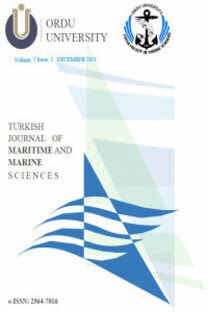Geomorphology of Hereke-Körfez area and its relation to the submarine morphology of the centre basin of the Gulf of Izmit
Bu çalışmada Hereke ile Körfez arasında uzanan, fakat gerçekte İzmit'e kadar çizgiselliği takip edilen fayın üzerindeki genç morfoloji ile, İzmit Körfezi orta çukurunun denizaltı morfolojisi arasındaki ilişki araştırılmıştır. Karada fay dikliği üzerindeki façeta oluşumları, drenajda kapma ve gömülme türünden değişiklikler, diklik önünde dar alanlı olarak korunmuş aşınım yüzeyi parçaları, fay dikliğine gömülen akarsuların kırıklı thalweg profilleri, delta istifleri üzerinde gelişen ve delta önü oyulmalarına karşılık gelen aktif denizaltı heyelanları ve en önemlisi deniz altında -40 - -160 m arasında kademeli faylarla kırılarak ayrılmış aşınım yüzeyi seviyeleri sahadaki aktif tektoniğin görünür delilleri arasındadır. İzmit Körfezi orta çukurunda 190 metrelik bir çökmenin meydana geldiği sonucuna varılmıştır. Bu sonuç, depresyondaki kademeli çökmelerin derine indirdiği derin vadi formu ile de desteklenmektedir. Hereke-Körfez fayı boyunca gelişen alüvyal yelpaze formları üzerinde dikkatle çalışılmalıdır. Bu zonda denizel taraçaların bulunmaması kuzeyden gelen malzeme ile mevcut olması muhtemel taraçaların maskelenmesi ve kademeli faylarla derine indirilmesini düşündürdüğünden derin sondajlarla fay dikliği önündeki güncel sedimentasyon ortamının derine doğru uzantısı ve stratigrafik dizilimi, dolayısıyla da ve fan-olası taraça ve temel istifi stratigrafik açıdan ortaya çıkmış olacaktır. Bu türde bir sondaj fan-deltaların sıralandığı kıyı boyunca derine indirilmiş olabileceğini belirttiğimiz aşınım yüzeyinin de mevcut olup olmadığını belgeleyecektir.
Hereke-Körfez arasının jeomorfolojisi ve İzmit Körfezi orta çukurunun denizaltı morfolojisi ile ilişkisi
The present study is an attempt to interpret the geomorphology of the Hereke-Körfez area and the submarine morphology of the Gulf of Izmit. Geomorphological investigations have been carried out on the E-W trending normal fault, Hereke-Körfez fault, which constitutes the northern segment of North Anatolian Fault (NAF). Along this 10 km-long zone, the morphological features of this area have been considered according to the neotectonic features within and around the stream basins. Fault facettas, stream captures, deep dissection in young valleys, hanging valleys, en-echelon erosional surfaces, convexity and slope breaks in thalweg profiles indicate the youth phase in fluwial geomorphological evolution. Active submarine landslides in front of the submarine deltas and the en-echelon erosional surface located at - 40 m to - 160 m imply the active tectonic in the Gulf of Izmit. The morphometric features of erosional surfaces indicate a collapse of about 190 m in the gulf. This result is supported by the deep valley form in the depression. It is concluded that this buried valley has been deepened by the en-echelon faultings. The aluwial cones developed along the Hereke-Körfez Fault. That there is no marine terrace in this zone appears to be related to the sediment input from north by the creeks, which covered the marine terraces probably. These terraces might have later been deepened by en-echelon faultings. Thus, the deep drill holes are needed to find out the vertical cross-section of these young deposits. This will also reveal if the en-echelon erosional surfaces have been deformed by the activity of NAF. Consequently, the hinterland morphology of the Gulf of Izmit could well be used as a reliable criteria to assess the morpho-tectonic features in this coastal area.
___
- ISSN: 1300-7122
- Yayın Aralığı: Yıllık
- Başlangıç: 2018
- Yayıncı: -
Sayıdaki Diğer Makaleler
A. Evren ERGİNAL, T. Ahmet ERTEK
Oil and detergent pollution of sea water in Dardanelles in 2001-2002
Kasım Cemal GÜVEN, Kartal ÇETİNTÜRK, Mustafa ALPASLAN, Ahmet Adem TEKİNAY
Ahmet Adem TEKİNAY, Pınar AKYÜZ, DERYA GÜROY, Ebru Gülçin KAHYAOĞLU, Mustafa ALPASLAN
